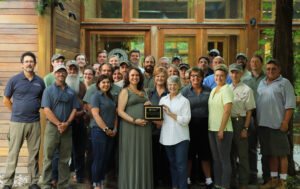By Mark Wourms

Bernheim prides itself in being a leader in ecological stewardship not only for the 15,625 acres of land that we have the privilege of protecting, but also beyond our borders through various programs, partnerships and initiatives. That’s why we were thrilled to receive the 2018 American Public Gardens Association (APGA) Operational Sustainability Award.
Bernheim is only the third organization to ever receive the honor from the leading professional organization in the field of public horticulture. With more than 600 member-organizations throughout the United States and around the world, APGA established the award to recognize outstanding dedication and achievements in promoting sustainability through programs, operations, facilities and/or research.
APGA cited Bernheim’s innovative conservation and land protection work as well as our commitment to helping people develop a deeper connection with and appreciation for nature.
Harry Jongerden, Executive Director of the Toronto Botanical Garden and Chair of the 2018 Awards Committee, called Bernheim’s work remarkable. ͞
“They exemplify the very best practices that we can all emulate,” said Jongerden.
While we strive to use and teach sustainable practices that do no harm to the environment, we are also leading regional efforts in regenerative practices that actually improve the health of our planet. Here are just some examples of the work that helps set us apart.
Sustainability in Operations
When Bernheim decided to establish an edible garden, we selected a 4-acre parcel of land adjacent to our research building that provided easy access to visitors and staff. As an applicant to the Living Building Challenge (LBC), Bernheim follows the principles of regenerative design in the garden, using only water from nature collected from surrounding buildings and the garden itself in cisterns and ponds. The 16 Solar Panels atop the garden shed generate 5,000 kwh per year, enough to cover the energy the garden will use in a year and then some. The produce we grow is then used to make the delectable offerings in Isaac’s Café located just 200 steps away, inside the Visitor Center.That’s what we call a low carbon foot print.
Sustainability in Facilities
One of Bernheim’s most popular attractions is our LEED Platinum Visitor Center, the first of its kind in a multi-state region when it was built in 2005. The building is made from the wood of recycled pickle vats. It is built in concert with the landscape to help save energy. Its glassed walls provide natural light reducing the need for electric lighting and countless other features make it a model for sustainable design. Just outside the Visitor Center is an electric vehicle (EV) charger where visitors can recharge their vehicle while they recharge their mind and body spending time in nature. The EV charger was the first of its kind in a park or natural area in the region.
Our work around sustainability in facilities extends beyond Bernheim to the installation and maintenance of green roofs in Louisville, including our most recent installation of four rooftop gardens on the newly constructed University of Louisville Novak Center for Children’s Health in downtown Louisville.
Sustainability in Programming
When you connect people with nature, they are more apt to want to protect it. That’s why Bernheim offers a range of programming for people of all ages. From our nationally recognized nature-based education programs and field trips for school-aged children to our horticulture classes for people who want to learn about sustainable gardening practices, the Bernheim team looks for ways to grow a community of environmental stewards. That is also why Bernheim established the Children at Play Network. Research shows that play and particularly unstructured free play in nature is critical to health, learning, creative problem solving, social rule making, and developing connections to nature.
Sustainability in Research
Bernheim’s wetland research is a prime example of work that not only sustains but improves the environment. Over the years, many of our region’s wetlands were lost to the straightening streams for agricultural lands, resulting in a loss of habitat for countless species. Bernheim has been working tore-engineer streams in the Wilson Creek bottom lands as seen on the Wilson Creek Stream Restoration site and on the upcoming Harrison Fork restoration site. The results are truly remarkable from improved water quality to increased biodiversity.
Bernheim’s work to protect bat habitat and its accompanying research precipitated the purchase of more than 1,000 acres of land over the past year thanks to the support of the Imperiled Bat Conservation Fund. With 12 of the 14 species of bats found in Kentucky on the land, Bernheim has constructed bat roosts where we can study nursing colonies and help set the conditions for these important animals to thrive.
Continuing a Legacy
It goes without saying that we could not be prouder of this distinction from APGA. We consider it a testament to Mr. Bernheim’s legacy. Please know that this award is just as much yours as it is ours. Our dedicated, expert staff’s commitment to environmental stewardship would not be possible without the support of members and donors. To celebrate, we invite you to come to the forest and connect with nature knowing that you a part of a rich legacy that will be enjoyed for generations to come.

